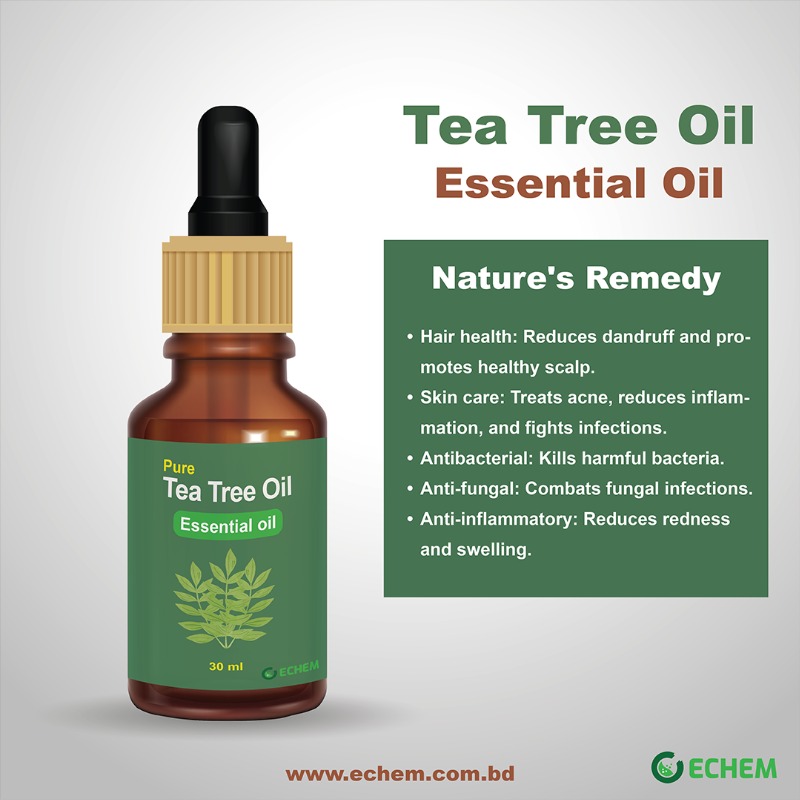Tea tree essential oil, derived from the leaves of the Melaleuca alternifolia tree native to Australia, is a popular natural remedy with a long history of use. It is known for its antimicrobial, antifungal, and anti-inflammatory properties, making it a versatile ingredient in various products.
Product Description
- Color: Clear to pale yellow
- Odor: Fresh, camphoraceous, and slightly medicinal
- Chemical Composition: Contains terpenes, such as terpinen-4-ol, which is the primary active compound.
- Density: 0.930-0.955 g/mL
- Solubility: Slightly soluble in water, soluble in alcohol
- CAS Number: 8000-28-0
- Botanical Name: Melaleuca alternifolia
- Common Name: Tea tree oil
- Extraction Method: Steam distillation
- Shelf Life: When stored properly, tea tree oil can have a shelf life of several years.
Usage Recommendations
- Skin Care: Tea tree oil can be used topically to treat acne, fungal infections, and minor cuts or scrapes. Dilute it with a carrier oil before applying to the skin.
- Hair Care: Add a few drops of tea tree oil to your shampoo or conditioner to help soothe scalp irritation and combat dandruff.
- Aromatherapy: Diffuse tea tree oil in the air to promote relaxation, clear the mind, and boost mood.
- Cleaning: Add a few drops of tea tree oil to your cleaning solution to disinfect surfaces and eliminate odors.
- Insect Repellent: Apply diluted tea tree oil to the skin to deter insects.
- Oral Health: Use a mouthwash containing tea tree oil to help freshen breath and fight bacteria.
Caution
- Skin Sensitivity: Tea tree oil can be irritating to sensitive skin. Perform a patch test before applying it to a large area.
- Oral Consumption: Do not ingest tea tree oil, as it can be toxic.
- Pregnancy and Breastfeeding: Consult with a healthcare professional before using tea tree oil if you are pregnant or breastfeeding.
- Eye Contact: Avoid contact with eyes. If eye contact occurs, rinse thoroughly with water.
- Storage: Store tea tree oil in a cool, dark place, away from heat and direct sunlight.
Tea tree essential oil, derived from the leaves of the Melaleuca alternifolia tree native to Australia, is a popular natural remedy with a long history of use. It is known for its antimicrobial, antifungal, and anti-inflammatory properties, making it a versatile ingredient in various products.
Key Features
- Botanical Name: Melaleuca alternifolia
- Common Name: Tea tree oil
- Extraction Method: Steam distillation
- Color: Clear to pale yellow
- Odor: Fresh, camphoraceous, and slightly medicinal
- Chemical Composition: Contains terpenes, such as terpinen-4-ol, which is the primary active compound.
- Density: 0.930-0.955 g/mL
- Solubility: Slightly soluble in water, soluble in alcohol
- CAS Number: 8000-28-0
- Shelf Life: When stored properly, tea tree oil can have a shelf life of several years.
- Antimicrobial Properties: Effective against bacteria, fungi, and viruses.
- Antifungal Properties: Helps treat fungal infections like athlete's foot and nail fungus.
- Anti-inflammatory Properties: Reduces inflammation and redness.
- Insect Repellent: Can deter insects.
- Aromatherapy: Promotes relaxation, clears the mind, and boosts mood.
Additional Information
- Tea tree oil is often used in skincare products to treat acne, fungal infections, and minor cuts or scrapes.
- It can be added to shampoo or conditioner to help soothe scalp irritation and combat dandruff.
- Tea tree oil can also be used as a natural disinfectant and cleaning agent.
- When using tea tree oil, it is important to dilute it with a carrier oil, such as coconut oil or jojoba oil, to prevent skin irritation.
- It is essential to perform a patch test before applying tea tree oil to a large area of skin.
- Tea tree oil should be stored in a cool, dark place, away from heat and direct sunlight.
- Consult with a healthcare professional before using tea tree oil if you have any underlying health conditions or are pregnant or breastfeeding.


Login To Comment